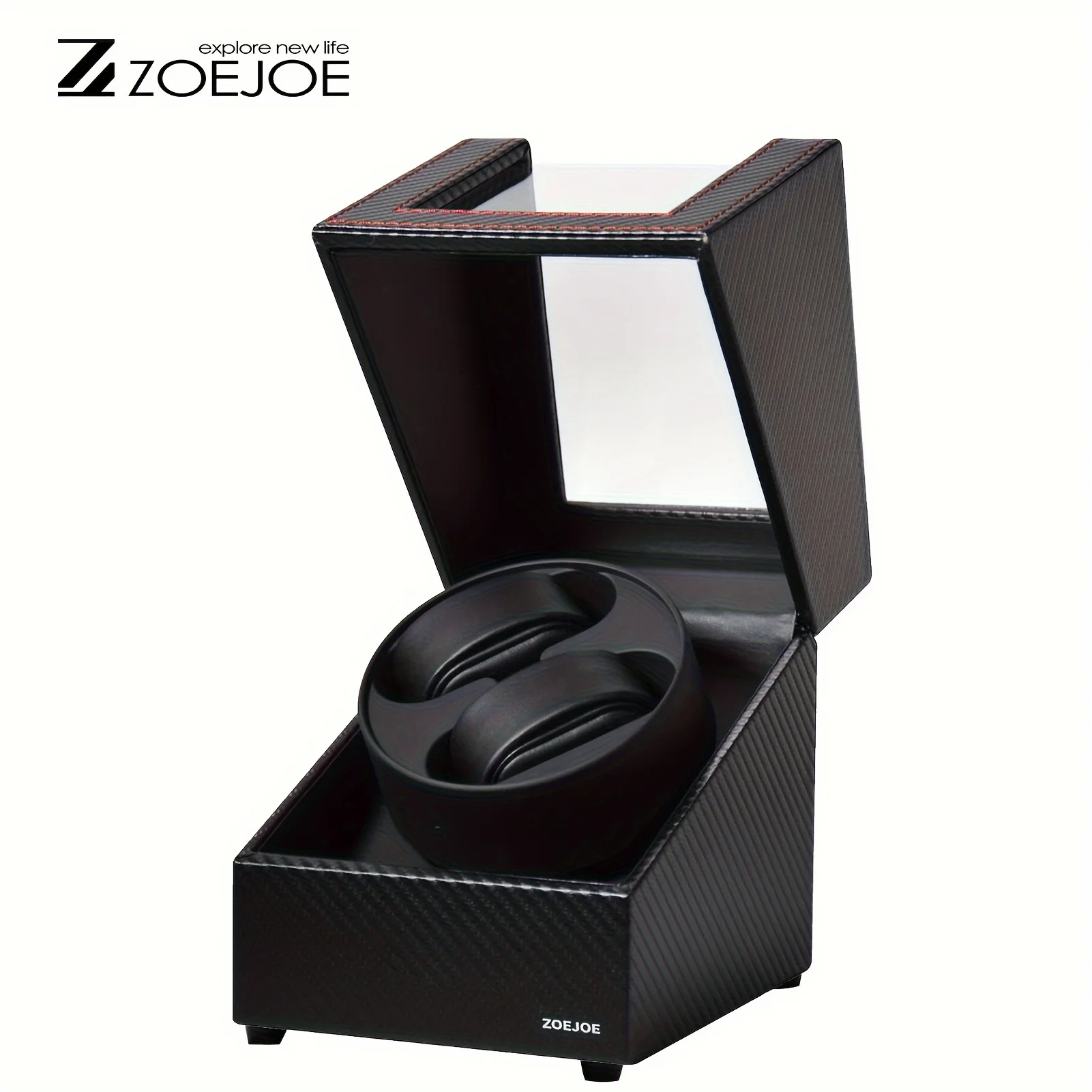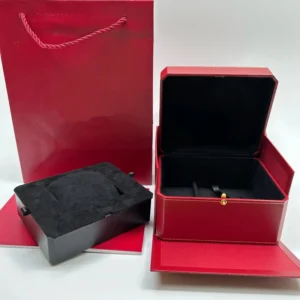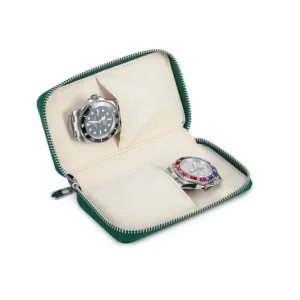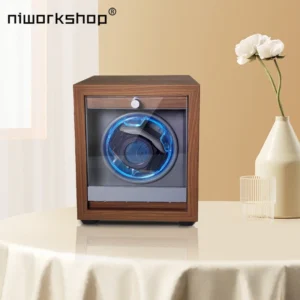Introduction
Watches have long transcended their role as simple timekeeping devices to become meaningful accessories that reflect personal style and craftsmanship. Whether adorned with a beautifully crafted wooden case or wrapped in supple leather, these timepieces deserve attentive care to maintain their appeal and functionality.
The case housing your treasured watch plays a crucial role in its protection and presentation. However, wood and leather—two natural materials prized for their warmth and character—respond very differently to everyday use and environmental factors. Without proper maintenance, a stunning wood case might develop cracks or lose its luster, while leather might dry out or become discolored.
Understanding the distinct maintenance needs of these materials is essential for preserving your investment. With proper care, a quality watch case can last for decades rather than mere years, continuing to protect and showcase your timepiece collection throughout its lifetime.
In this comprehensive guide, we’ll explore the distinct maintenance needs of both wood and leather watch cases, providing you with expert knowledge to preserve your timepiece’s beauty and functionality for years to come. From cleaning techniques to conditioning methods and protection strategies, you’ll learn everything needed to keep your wood or leather watch boxes in optimal condition.
Understanding Material Properties: Why Maintenance Differs
Before diving into specific maintenance routines, it’s important to understand why wood and leather require different care approaches. Their fundamental structures determine how they respond to environmental factors and wear.
Wood Properties
Wood is composed of cellular structures with varying densities and grain patterns. These natural cells once transported water and nutrients when the tree was alive. After harvesting and treatment, this cellular structure remains, making wood:
- Hygroscopic (absorbs and releases moisture based on environment)
- Subject to expansion and contraction with humidity changes
- Vulnerable to UV radiation that breaks down lignin (the natural “glue” holding wood cells together)
- Naturally porous, requiring oils to maintain moisture balance
Different wood species used in watch cases—like walnut, maple, or bamboo—have varying densities and oil content, which influence their durability and maintenance needs.
Leather Properties
Leather consists of collagen fiber bundles derived from animal hide. The tanning process transforms these fibers into a durable, flexible material by:
- Replacing natural water content with preservative substances
- Creating cross-links between protein fibers for durability
- Introducing oils that maintain flexibility
These structural differences mean leather requires regular replenishment of oils and moisture to prevent drying and cracking, while wood needs protection from moisture fluctuations and UV damage.
Understanding these durability factors of wood and leather watch cases helps explain why maintenance routines differ significantly between these materials.
Wood Watch Cases: Composition and Vulnerabilities
Common Wood Types Used
Watch case manufacturers typically select hardwoods known for their stability, beauty, and durability:
- Walnut: Rich dark tones with excellent dimensional stability
- Maple: Light color with tight grain and high resistance to wear
- Bamboo: Technically a grass but used for its sustainability and strength
- Sandalwood: Prized for its aromatic qualities and fine texture
These materials bring natural warmth, unique grain patterns, and lightweight comfort that synthetic materials cannot replicate. Each piece contains one-of-a-kind patterns, making every wood watch case unique.
Key Vulnerabilities
Despite their beauty, wood watch cases have several vulnerabilities that require specific maintenance:
- Moisture sensitivity: Excessive humidity causes swelling while dryness leads to shrinking and potential cracking
- Scratching and denting: Wood’s cellular structure can be compressed or damaged by impact
- UV damage: Prolonged sun exposure breaks down surface cells, causing fading and deterioration
- Temperature fluctuations: Rapid changes can stress the wood structure, leading to warping or cracking
- Oil depletion: Natural oils evaporate over time, making wood brittle without replenishment
These vulnerabilities explain why wooden watch boxes require specific care routines. The Janka hardness scale measures wood’s resistance to denting and wear—for example, maple (1,450 rating) offers greater dent resistance than walnut (1,010 rating), but both need protection against their inherent vulnerabilities.
Our wooden watch boxes collection includes various wood types, each requiring specific maintenance approaches based on these natural characteristics.
Leather Watch Cases: Composition and Vulnerabilities
Types of Leather
Watch cases utilize several leather grades, each with different maintenance requirements:
- Full-grain leather: Contains the complete grain layer with natural markings, highest durability
- Top-grain leather: Slightly sanded surface for more uniform appearance
- Genuine leather: Made from lower hide layers, less durable but more affordable
- Bonded leather: Composed of leather scraps bonded with adhesives, requires most frequent maintenance
The appeal of leather comes from its supple texture, ability to develop a beautiful patina over time, and traditional luxury appearance.
Key Vulnerabilities
Leather watch cases face several challenges that necessitate regular maintenance:
- Drying and cracking: Without conditioning, leather loses natural oils and flexibility
- Oil and sweat absorption: Direct contact with skin transfers oils that can stain or degrade leather
- Water sensitivity: Water spots damage leather’s surface and can cause warping or stiffening
- UV fading: Sunlight breaks down the dyes and proteins in leather, causing color loss
- Staining susceptibility: Leather readily absorbs liquids and colorants
- Odor development: Improper storage can lead to mildew growth or unpleasant smells
Understanding these vulnerabilities explains why proper leather watch case cleaning is essential. The quality of leather dramatically affects its durability and maintenance needs—full-grain requires less frequent conditioning than genuine leather but still needs regular care.
Our leather watch boxes showcase various leather types that benefit from appropriate maintenance routines.
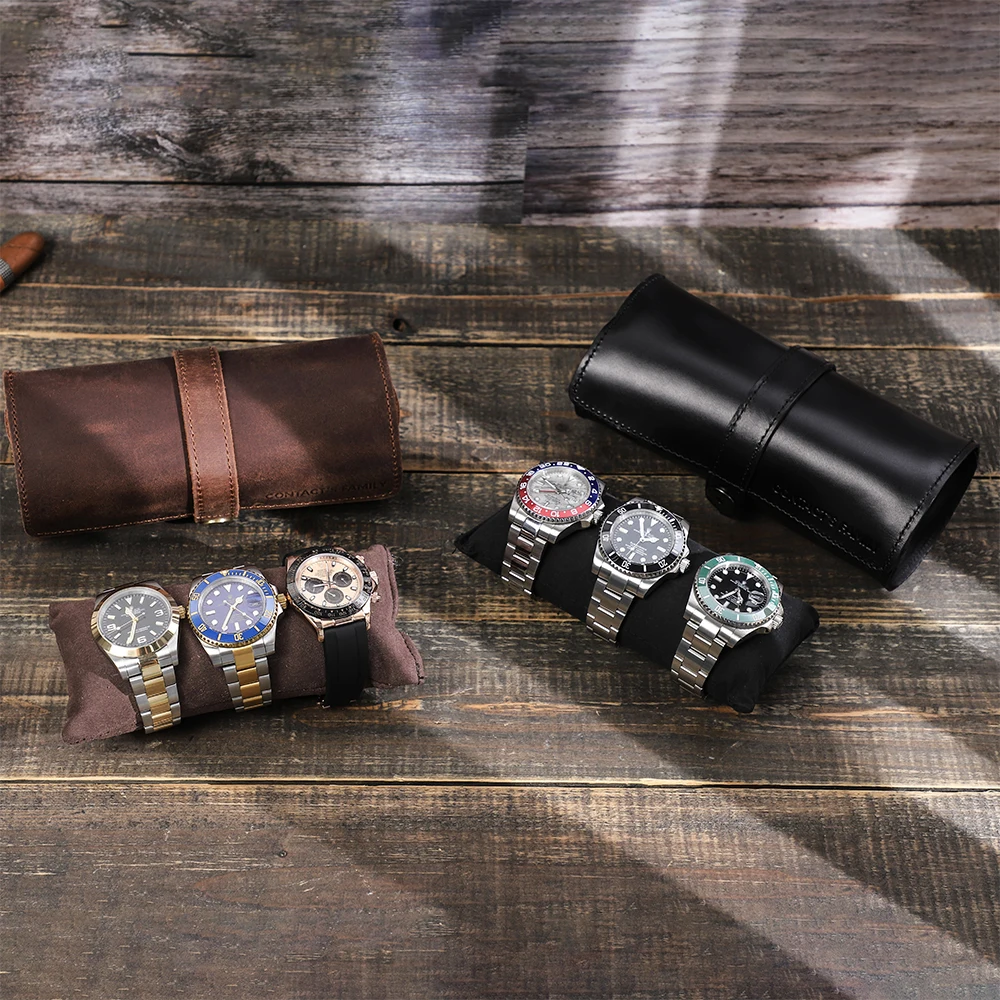
Maintenance Comparison: Wood vs. Leather Watch Cases
To help you understand the key differences in care requirements, the following comparison highlights the main maintenance aspects for both materials:
| Maintenance Aspect | Wood Watch Cases | Leather Watch Cases |
|---|---|---|
| Cleaning Frequency | Every 1-2 months | Every 2-4 weeks |
| Recommended Cleaning Agents | Mild soap (minimal water), specialized wood cleaner | Leather-specific cleaner, saddle soap |
| Conditioning Frequency | Every 6-12 months | Every 3-6 months |
| Conditioning Products | Food-grade mineral oil, beeswax, specialized wood oil | Leather conditioner, mink oil (for certain leathers) |
| Protection Methods | UV-protective finish, humidity control | Leather protector spray, moisture barriers |
| Environmental Concerns | Keep at 40-60% humidity, avoid direct sunlight | Keep at 45-55% humidity, avoid heat sources |
| Common Issues | Drying, cracking, warping, color fading | Drying, cracking, staining, odor development |
| Expected Lifespan with Proper Care | 20+ years | 10-15 years (varies by leather quality) |
The fundamental difference in maintenance approach stems from wood being a more dimensionally stable material when properly finished, while leather requires more frequent conditioning to maintain its flexibility and prevent deterioration.
Both materials benefit from careful handling and proper storage, but leather generally demands more regular attention due to its direct exposure to body oils and environmental factors. Understanding these differences helps inform your wood versus leather watch storage decisions based on your lifestyle and willingness to perform maintenance.
Essential Maintenance for Wood Watch Cases
Daily Care Practices
Proper daily habits significantly extend the life of wooden watch cases:
- Handle with clean, dry hands to prevent oil transfer
- Wipe dust with a soft microfiber cloth using gentle, directional strokes
- Keep away from bathrooms, kitchens, and other high-humidity areas
- Store in a climate-controlled environment when not in use
- Avoid exposure to direct sunlight or heating/cooling vents
Cleaning Process
When your wood case needs deeper cleaning:
Gather materials:
– Soft microfiber cloths (lint-free)
– Soft-bristled brush (like a clean makeup brush)
– Wood-safe cleaner or mild soap solution (minimal water)Cleaning steps:
– Remove dust using a dry microfiber cloth
– For stubborn dirt, slightly dampen cloth with wood cleaner or mild soap solution
– Wipe in the direction of the wood grain
– Immediately dry completely with a clean cloth
– Allow to air dry fully before applying any conditionersWhat to avoid:
– Household furniture polish containing silicones
– Excessive water or soaking
– Ammonia-based cleaners
– Abrasive cloths or paper towels
Conditioning and Protecting
Keep wood nourished and protected with regular conditioning:
- Select appropriate wood oil (food-grade mineral oil, specialized wood oil, or beeswax-based products)
- Apply a small amount to a soft cloth—never directly on the wood
- Gently rub into wood following the grain pattern
- Allow to penetrate for 5-10 minutes
- Buff away excess oil with a clean cloth
- Repeat every 6-12 months or whenever wood appears dry
For optimal protection, store wooden watch cases in wooden watch holders designed to maintain proper positioning while allowing air circulation.
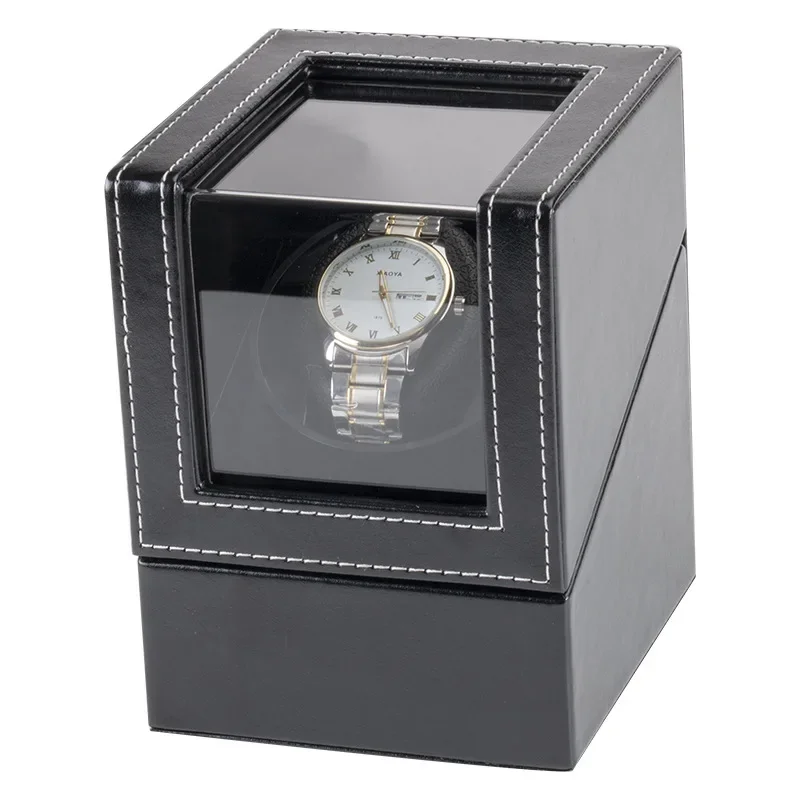
Essential Maintenance for Leather Watch Cases
Daily Care Practices
Develop these habits to maintain leather watch cases:
- Handle with clean hands to minimize oil transfer
- Wipe down with a dry microfiber cloth after handling
- Allow air circulation after wear (avoid sealed plastic storage)
- Keep away from direct sunlight and heat sources
- Never place heavy objects on leather cases
Cleaning Process
For effective leather cleaning:
Gather materials:
– Microfiber cloths
– Leather-specific cleaner
– Small soft-bristled brushCleaning steps:
– Remove surface dust with a dry cloth
– Apply a small amount of leather cleaner to a cloth (not directly on leather)
– Gently work into the leather using circular motions
– Wipe away residue with a clean, slightly damp cloth
– Allow to dry completely away from heat sourcesFor different soil levels:
– Light cleaning: Dry cloth wipe-down
– Moderate cleaning: Leather cleaner application
– Deep cleaning: Multiple gentle applications rather than one aggressive cleaning
Conditioning and Protecting
Regular conditioning prevents leather from drying and cracking:
- Select an appropriate leather conditioner matching your leather type
- Test in an inconspicuous area first
- Apply a small amount to a soft cloth
- Work into leather using circular motions
- Allow to absorb for 1-2 hours
- Buff away any excess
- Apply every 3-6 months or when leather feels dry or stiff
Whether you should oil your leather watch depends on the specific type and finish. For travel protection, consider using leather watch travel cases designed to prevent damage during transport.
Environmental Considerations and Protection
Both wood and leather are natural materials significantly affected by their environment, requiring specific conditions for optimal preservation.
Ideal Climate Conditions
- Wood optimal environment:
- Humidity: 40-60%
- Temperature: 65-75°F (18-24°C)
Stable conditions without rapid fluctuations
Leather optimal environment:
- Humidity: 45-55%
- Temperature: 60-75°F (15-24°C)
- Air circulation without direct drafts
Protection Strategies
Implement these protective measures based on your local climate:
- Humid environments:
- Use silica gel packets in storage areas
- Consider a dehumidifier in storage rooms
- Increase air circulation around cases
More frequent inspections for mold or mildew
Dry environments:
- Use a humidifier during dry seasons
- More frequent conditioning of both materials
Avoid positioning near heating vents
UV protection:
- Store cases away from windows
- Use UV-filtering display cases for exhibited pieces
- Consider window treatments that block harmful rays
Seasonal maintenance adjustments help compensate for environmental changes—more frequent conditioning in winter when indoor heating reduces humidity, and vigilant protection of leather watch cases from moisture during humid summer months.
Troubleshooting Common Issues: Wood Watch Cases
Even with proper maintenance, wood watch cases may develop issues over time. Here’s how to address common problems:
Minor Scratches and Dents
For shallow scratches:
– Clean the area thoroughly
– Apply a small amount of mineral oil to rehydrate the wood
– For persistent scratches, lightly sand with 600-grit sandpaper in the direction of the grain
– Apply matching wood oil to blend the repairFor dents:
– Place a damp cloth over the dent
– Gently apply a warm iron over the cloth (not directly on wood)
– The steam helps wood fibers expand back into position
– Allow to dry completely before conditioning
Dryness and Cracking
- Clean the case thoroughly
- Apply several light coats of wood conditioner over several days
- Allow each application to fully absorb before the next
- For minor cracks, wood filler matching your wood tone may help
Warping Prevention
- Store wood cases flat on a level surface
- Maintain consistent humidity levels
- For slight warping, gradually reshape by applying gentle pressure with humidity control
- Severe warping may require professional restoration
These solutions address many disadvantages of wooden watches and their storage cases through proper intervention and maintenance.
Troubleshooting Common Issues: Leather Watch Cases
Leather watch cases face different challenges requiring specific remedies:
Dryness and Cracking
- Clean leather thoroughly
- Apply leather conditioner in thin, multiple layers
- Allow 24 hours between applications
- For severe cases, use a specialized leather restoration product
Water Damage
For fresh water exposure:
– Blot immediately with absorbent cloth (don’t rub)
– Allow to air dry naturally away from heat
– Once completely dry, apply leather conditionerFor set water stains:
– Dampen entire section evenly for uniform drying
– Use leather cleaner followed by conditioner
– Severe cases may require professional treatment
Stain Removal
Different stains require specific approaches:
- Oil stains: Blot excess, apply cornstarch to absorb oil, brush away after several hours
- Ink stains: Dab (don’t rub) with alcohol on a cotton swab, working from outside in
- Food stains: Clean with leather cleaner, followed by conditioner
Odor Elimination
- Air out in well-ventilated area
- For persistent odors, place in a box with baking soda nearby (not directly on leather)
- Specialized leather deodorizers can help with stubborn smells
Watch Accessories, Watch Holder
$94.51 Select options This product has multiple variants. The options may be chosen on the product pageLuxury Watch Boxes, Men's Watch Boxes, Single Watch Box
Price range: $903.35 through $980.97 Select options This product has multiple variants. The options may be chosen on the product pageLuxury Watch Boxes, Luxury Watch Travel Case
Price range: $200.33 through $224.57 Select options This product has multiple variants. The options may be chosen on the product pageLeather Watch Travel Case, Men's Watch Travel Case, Watch Roll Travel Case
Price range: $91.37 through $92.63 Select options This product has multiple variants. The options may be chosen on the product pageAutomatic Watch Winder, Single Watch Winder, Wooden Watch Holder
$201.76 Select options This product has multiple variants. The options may be chosen on the product pageAutomatic Watch Winder, Leather Watch Travel Case, Single Watch Winder
$146.30 Select options This product has multiple variants. The options may be chosen on the product page
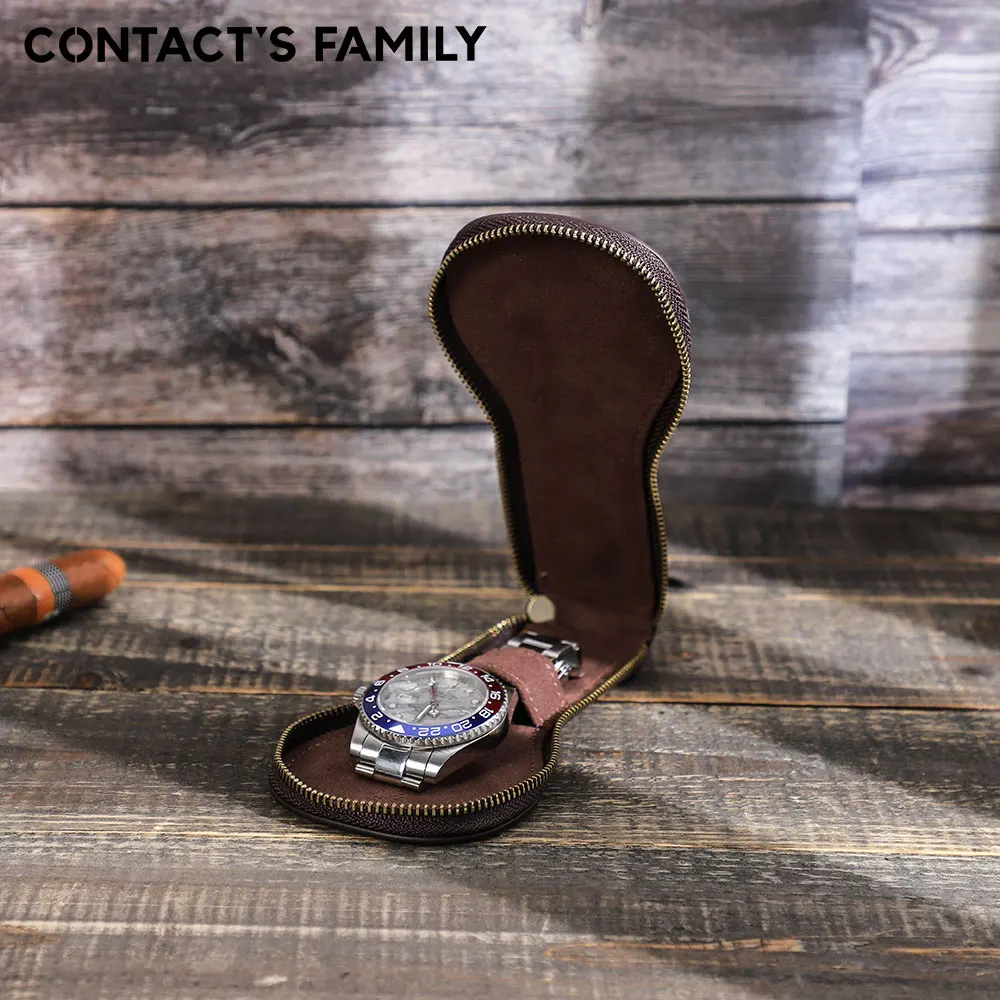
Professional Care vs. DIY Maintenance
While many maintenance tasks can be performed at home, sometimes professional intervention becomes necessary.
When to Seek Professional Help
Consider professional service when:
– Deep cracks appear in wood cases
– Leather shows severe discoloration or damage
– Hardware components become loose or damaged
– Water damage penetrates beyond surface level
– Mold or mildew becomes established
– Valuable antique pieces need restoration
Cost Considerations
Professional services typically range from:
– Basic cleaning: $30-60
– Minor repairs: $50-100
– Major restoration: $100-300+
These investments often prove worthwhile for preserving valuable collections housed in premium cases.
Finding Qualified Professionals
Look for specialists with:
– Experience with the specific material (wood or leather)
– Portfolio of similar restoration projects
– Understanding of watch storage requirements
– Clear explanation of processes and materials used
– Positive testimonials from collectors
Before entrusting your valuable pieces to a professional, prepare by gathering an essential watch maintenance kit for routine care you can perform yourself.
Essential Tools and Products for Watch Case Maintenance
Building a maintenance kit helps ensure you have appropriate tools on hand for regular care.
Wood Watch Case Care Essentials
- Cleaning tools:
- Microfiber cloths (lint-free)
- Soft-bristled brushes
Compressed air canister for crevices
Cleaning solutions:
- Mild soap solution (minimal water)
Specialized wood cleaner without silicones
Conditioning products:
- Food-grade mineral oil
- Beeswax-based wood conditioner
- Carnauba wax for final protection
Leather Watch Case Care Essentials
- Cleaning tools:
- Microfiber cloths
- Soft leather brushes
Cotton swabs for detail work
Cleaning solutions:
- pH-neutral leather cleaner
Saddle soap for deeper cleaning
Conditioning products:
- Leather conditioner appropriate for your leather type
- Leather protectant spray
- Mink oil (for certain leather types)
For both materials, proper cleaning products for leather watch boxes and wood cases should be selected based on the specific finish and material quality.
The Investment Perspective: Maintenance and Value Preservation
Regular maintenance should be viewed not as a chore but as protection for your investment in quality watch cases.
Value Preservation Benefits
- Maintained wood cases can retain 80-90% of their value over decades
- Well-conditioned leather develops a desirable patina that enhances aesthetic value
- Functioning hardware and intact finishes significantly impact resale potential
- Documented care history increases buyer confidence for collectible pieces
Cost-Benefit Analysis
The modest investment in quality care products provides substantial returns:
– Basic maintenance supplies cost $30-60 annually
– Professional cleaning every few years: $50-100
– Potential value preservation: Hundreds to thousands of dollars depending on the collection
Sustainability Considerations
Proper maintenance also supports environmental responsibility:
– Extended product lifespan reduces waste
– Fewer replacement purchases conserve resources
– Many natural care products have minimal environmental impact
Investing in luxury watch boxes with proper maintenance not only preserves their beauty but maintains their functional value as protective storage for valuable timepieces.
Frequently Asked Questions
Can I use household furniture polish on my wood watch case?
No, avoid standard furniture polishes as they often contain silicones that build up over time. Instead, use products specifically formulated for fine wood without synthetic additives.
How often should I condition my leather watch case?
Condition leather every 3-6 months, or more frequently in dry climates. If the leather feels stiff or looks dull, it’s time to condition regardless of schedule.
Is it normal for wood watch cases to change color over time?
Yes, wood naturally darkens or develops a patina with age and exposure to air and light. This process can be slowed with UV protection but is part of wood’s natural aging process.
Can leather watch cases be worn during exercise or swimming?
No, avoid exposing leather to excessive sweat or water. The moisture and salts accelerate deterioration and can cause permanent damage to leather cases.
How do I store my watch when not wearing it for extended periods?
Store in a climate-controlled environment with stable humidity (40-60%), away from direct sunlight. Use storage that allows some air circulation while protecting from dust.
Can scratched wood watch cases be repaired?
Minor scratches can often be addressed with proper oiling or light sanding and refinishing. Deep gouges may require professional restoration or acceptance as character marks.
How do I know if my leather watch case needs conditioning?
If the leather feels stiff, appears dull, or shows fine lines when gently flexed, it needs conditioning. Well-conditioned leather feels supple and has a soft luster.

